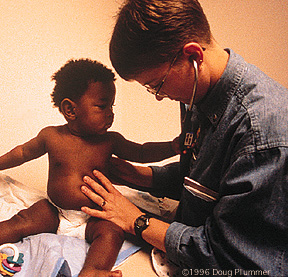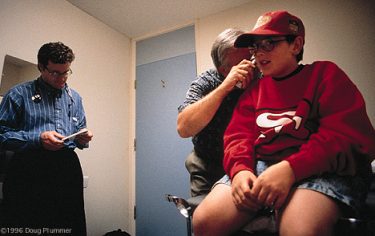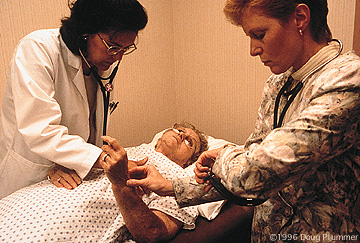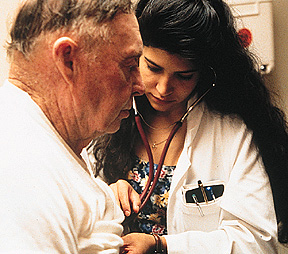In rural training, many doctors find a home
Seattle native Peter Rice said good-bye to the city when he graduated from high school. He headed north to Alaska, where he worked at construction sites, on boats and in logging camps. But there came a time when he left the groves of Douglas fir for the groves of academe.
At age 26, he earned a degree in biology from the University of Alaska. Several professors encouraged him to stay in his adopted state and help others, so he continued on at the University of Alaska to complete his first year of medical school.
Alaska doesn’t have a medical school in a bricks-and-mortar sense. But it does have something called WWAMI Spread out over one-quarter of the United States land mass, this program encompasses Washington, Wyoming, Alaska, Montana and Idaho and takes its name from the initials of the participating states—WWAMI (pronounced “whammy”). Its mission: joining forces with the University of Washington to educate medical students.
Basic science faculty at six state universities teach the first-year, UW faculty in Seattle teach the second year, and UW and community health professionals in towns throughout the region train future doctors at several stages, notably during the last two years of medical school.
In Rice’s case, many professors he knew as an undergraduate were his first-year medical school teachers. With only 12 students in his class, Rice got individualized attention in anatomy and other subjects. For second-year courses in Seattle, his small class joined UW medical students from the other participating states, forming a medical school class of about 160.

Infant Devin Washington gets a check up from family practice resident Melissa Ashby at a Spokane clinic that serves as a WWAMI site.
“I took my third-year psychiatry clerkship, and obstetrics and gynecology clerkship in Anchorage,” Rice recalls. He made rural health field trips to Bethel, a mostly Alaska Native village where the local doctors cover an area the size of Oregon, and also to Marshall, a village north of Bethel on the Yukon River.
“It was good exposure to see how health care was delivered in the bush,” he says.
“All these experiences were part and parcel of what I felt was a welcoming, supportive atmosphere for doctors-in-training who wanted come back to Alaska,” Rice says.
In 1988, when his residency in internal medicine at the University of Washington was over, one of his mentors invited him to practice in Ketchikan, a 17,000-person settlement in southeastern Alaska accessed only by boat or plane. Ketchikan is a place of seagoing splendor, but it could also be one of profound isolation if it weren’t for the professional relationships the doctors and local hospital have with sister institutions elsewhere, including the University of Washington.
“While WWAMI is known for training rural physicians, a lot of people don’t realize the amount of professional support the UW medical school continues to give to practicing health professionals in small medical communities like ours, or to much smaller ones with only one doctor,” Rice says.
In June, Rice penned a commentary in the Ketchikan Daily News about his town’s links with the UW—the availability via airlift of the trauma and burn centers at Seattle’s Harborview Medical Center, a free phone line for physicians to consult with a UW specialist day or night, Internet access to patient data, and visits from UW medical faculty to Ketchikan.
In this age of for-profit hospital chains traded on Wall Street, Rice wrote, it’s important for communities like Ketchikan to support public teaching institutions like the UW, and important for him to be affiliated with organizations that are values driven, not profit driven.
Values drive many physicians to seek a rural practice. On the Idaho side of the Teton Mountains sits Driggs, population 941, and its physician, 1983 UW medical school graduate Larry Curtis. “I want to practice where my patients are my friends,” he had told his dad when they drove up from Pocatello to look for an office location.
“I’d never seen Driggs before, but something there clicked for me,” Curtis says. He had traveled the world, courtesy of the U.S. Navy. Called up for the draft during the Vietnam War, he worked on submarines, in satellite communications and in jungle survival. A knee injury sent him to the San Diego Balboa Naval Hospital. During recovery, he promised himself he would do what he wanted with his life. While repairing some EKG and X-ray machines, he decided to become a physician.

Dr. Larry Curtis in his office in Driggs, Idaho.
When he entered medical school, Curtis had a wife and four children (a fifth arrived soon afterward). He says the UW medical school recognized the significance of a student’s home life in an eventual practice decision. Curtis wanted to practice in a place where he could be honest with his patients and look out for their best interests.
“If I tell them to quit smoking, they know I’m serious and they don’t take it as an imposition,” he says.
He also discovered that big-city physicians greatly admire their brethren in the “sticks.” “During my WWAMI training I found that most specialists respected rural physicians for their ability to handle many complicated situations. They have to, because they are so far away from advanced specialty hospitals,” Curtis says. “At fall harvest, an injured farmer might not want to travel for treatment. He might ask, `Sew me up quick, doc, so I can get back to work.’ I talk by phone with specialists in Idaho Falls or at the UW about a plan of care to see if they agree, and then institute it. ”
Curtis and his practice partners also use advanced telecommunications, such as two-way interactive video, to contact their colleagues at the UW for medical consultations.
Rice and Curtis have found a good fit: towns that need them and a place where they feel at home. “If physicians are where they feel balanced professionally and personally,” says Medical School Associate Dean John Coombs, “they are more likely to stay.”
Training doctors for areas with shortages of health professionals and keeping them there is a perennial problem for U.S. medical schools. Coombs explains that new physicians often find it hard to make the transition from university medical centers to practice in an altogether different setting. Many city hospitals have patient census and staffing larger than the population of small Western towns.
Although the country doctor shortage is not as severe as in years past, the demand is still pervasive throughout the rural landscape of the Northwest. The plains, isolated villages and places with geological barriers or harsh weather are hit the worst.
Twenty-seven years ago, urged by small-town physicians who witnessed their numbers dwindling, the UW medical school created a formal program to prepare more physicians for rural practice. Today UW medical students can take required third-year courses at 37 sites in five states, residents (recent M.D. graduates from around the nation) train at 25 sites, and nearly a hundred rural physicians open their homes and clinics to medical students for one-on-one elective placements for the summer. The medical school also oversees a physician assistant training program, and has joined other UW health sciences schools in a new initiative for interprofessional training among students in nursing, medicine, pharmacy and other health professions.

Dr. Ronald Miller, the WWAMI family practice coordinator in Whitefish, Mont., examines patient Brian Thramer, while his WWAMI student, Ross Bethel, looks on.
Since the WWAMI program started, 2,864 students have graduated from the UW medical school. About 10 percent practice in rural areas, according to the American Medical Association Physician Masterfile. A winter survey of UW residency graduates showed that 57 percent practice in WWAMI-land.
That a major research institution like the UW School of Medicine would educate students in community practice was considered a heresy to some medical educators at the start of the WWAMI Program.
“In the 1970s, a number of medical students were beginning to focus on the education of the generalist physician, but there was a notion this had to be separate from a scientific center. This seemed wrong to me. I felt the two should go hand in hand,” recalls Theodore Phillips, who founded the Department of Family Medicine and later was associate dean for academic affairs. Over the years, Phillips was proven right.
“Towns and hospitals around the WWAMI region like having UW students and residents,” says Assistant Dean Philip Cleveland. “The involvement of these small communities has been the cornerstone of the UW’s achievements in rural medicine.”
Dayton, Wash., a town of 2,597 in the southeast corner of the state, is one of nearly a hundred examples across the WWAMI map. When medical students come to train with Michael Luce, as they have most summers for the past 10 years, they notice that the occupation of “country doctor” suits Luce to a T. He provides health care to everyone from great-grandmothers to their seconds-old descendants.
Most community physicians like Luce teach for the UW as unpaid volunteers. When passing on their medical skills and knowledge, they add something more: they make plain their daily lives so that students can determine if that is how they, too, want to live.
Community faculty often leave the doors to their offices ajar. Students feel free to come in and talk with them about academic or personal matters. Many also give their time to civic causes. They take their medical students with them to kindergarten health screenings; to sporting events where they are the team physicians; to first-aid tents at parades, rodeos and canoe races; to ranger stations to give physicals to volunteer forest firefighters; and to search and rescue teams in the wilderness.
Shrinking the hundreds of miles between the medical school and outlying physicians calls for electronic ingenuity coupled with human compassion and friendliness. Many UW medical faculty connect to rural physicians through the MEDCON phone consulting service, or sit at one of the UW telemedicine stations. Not only can UW and rural doctors see and talk to each other through a high-speed link, they can jointly review diagnostic images, such as X-rays or ultrasounds.

Dr. Rebecca Anderson checks patient Doris Ashbrook’s vital signs at a WWAMI site in Missoula, Mont. Training with her is Renee Stapleton.
Like TV sports commentators during instant replays, they use computer pens to circle questionable spots: Does this the ultrasound image show a surgically repairable birth defect on the fetus? Is there a hairline fracture on this X-ray of an injured high school athlete? Doctors at both ends of the circuit can even put on long-distance stethoscopes. Together, they can listen to, then discuss, the heart or lung sounds of a patient.
Doctors also can consult with UW physicians via the Internet, tap into UW health sciences library resources, and send and receive patient records and diagnostic images over a high-security graphic Web system called U-Link. For example, a rural doctor can transmit a picture of a patient’s skin rash, and have a UW dermatologist comment on what it might be.
Communications technology also lets rural physicians keep pace with rapid advances in medical knowledge. In a speech to WWAMI leaders, Medical School Dean Paul Ramsey pointed out that much of the medical information required by the average physician is out-of-date in five years. For overworked rural physicians, who often can’t get away to attend conferences, staying current can be daunting. The UW is starting several electronic endeavors to instruct rural doctors via videotapes, telemedicine or the Web.
Another way the medical school helps future rural doctors is through research. By conducting a study of their own, medical students can discover how data is gathered, what makes for good methodology, and how findings are accurately and fairly interpreted.
“Performing research teaches a person how to figure out how to do new things, how to decide what the next step is,” says Peter Byers, professor of medicine and pathology and head of the Medical Student Summer Research Training Program. Understanding research methods is extraordinarily useful to rural physicians, Byers says, because they work apart from formal academic centers. On their own, they must sort through published studies, decide what’s relevant, understand drug marketing and reports of disease outbreaks, and how all this relates to their own patient population.
Coombs notes that the medical school is seeking ways for students at distant sites to do research on location. Medical student Erica Peterson, who this past spring spent six months training in Hailey, Idaho, entered medical school after working in a molecular biotechnology lab. She plans to take her research skills on the road to explore such rural issues as the consequences of pesticide exposure.
A self-described “mountain girl” because of her upbringing in the Rockies and her passion for high-altitude sports, Peterson also wonders if there’s an increased risk of breast cancer among women in certain geographical locations. If this is so, Peterson plans to look for causes and see if mammography screening should be encouraged more in those towns.

Sandra Gomez checks patient Joseph Dunbar during her clerkship in Havre, Mont.
WWAMI officials hope that women like Peterson will even out the demographics of rural practice. Nationally, women doctors are five to six times less likely than their male counterparts to practice in small towns. The medical school is also striving to correct the under-representation of minorities in medicine, an imbalance found in small towns and cities alike.
Michael Snook, a 1979 medical alumnus and a family physician in Colville, Wash., and Spokane, was part of a team that created the nation’s first rural residency track. In his experience, rural towns would warmly welcome physicians of either gender or any race or nationality. His feels exaggerated media reports of trouble in isolated outposts, such as neo-Nazi activity in northern Idaho or “freemen” in eastern Montana, give students the wrong impression of rural areas. Also, he says that the clamor for primary-care doctors in rural towns somewhat overshadows the accompanying lack of sufficient specialists to serve those areas.
Although the impetus for WWAMI was to train physicians for small towns, its approach of balancing university training with direct community participation has been adapted to train physicians for inner-city neighborhoods and for the care of needy populations, such as the homeless, and for groups that would benefit from medical services more in tune with their culture. Native Americans, Native Alaskans and migrant workers are among them.
Methods tried and proven in WWAMI—tapping the teaching expertise of the region’s professionals, local participation in public policy studies and interstate cooperation among public universities—might be models for other forms of regional collaboration outside of the health sciences, suggests Stephen Guggenheim, director of the WWAMI Program at Montana State University in Bozeman.
Even as it is held up as an example for other parts of the nation and other academic disciplines, even as it preserves the humanistic traditions of medicine, the WWAMI Program constantly regears itself to stay ahead of the times. Studies conducted on health workforce issues at the WWAMI Rural Health Research Center, and projects of the Center for Medical Education Research and individual investigators, measure success and offer direction for change. Opinions of community health professionals are regularly sought.
“WWAMI is an idea that works,” Coombs once told the region’s legislators. “It’s also an idea that doesn’t stand still.”